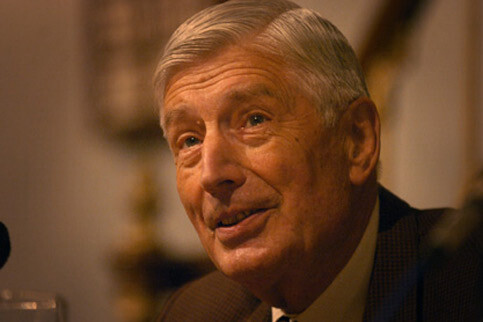United Civilians for Peace 25 August 2005

Former Dutch prime minister Andreas Van Agt.
From 22-28 August 2005 a delegation of (former) politicians and representatives of civil society organisations visits Israel and Palestine. The delegation is headed by Prof. Andreas van Agt, former Prime Minister of the Netherlands. The members of the delegation witness developments on the grounds meet with officials and civil society representatives on both sides. They report on their findings through a weblog and a press conference at the end of the mission.
23 August 2005
After a short night, the delegation experienced an impressive day of its fact finding mission to Israel and the Occupied Palestinian Territories.
In the morning, a settlement tour was conducted in the East-Jerusalem area. The tour was guided by Jeff Halper, head of the Israeli Committee Against House Demolitions. The delegation saw various settlements, which are continuously expanding and thereby undermining any prospect of a viable Palestinian state. On its way, the delegation also encountered Israel’s illegal Wall in the West Bank, which is being constructed at an unprecedented speed.
The delegation then had lunch with Hanan Ashrawi, a member of the Palestinian Legislative Council. She was accompanied by another Palestinian parliamentarian, Azmi el Shuaibi, and Sumaya Nasser, a Palestinian writer.
Consequently, the delegation embarked on a trip from Ramallah to Bethlehem, taking a detour that Palestinians are forced to take as a result of movement obstructions imposed by the Israeli authorities on all Palestinians indiscriminately. The trip, which should usually take about 40 min. at the maximum, took close to two hours and had almost twice the length of the actual distance between both cities, because of the fact that Jerusalem is not accessible for Palestinians from the West Bank and the Gaza Strip. The delegation passed two checkpoints on this route, which prevent Palestinians from moving freely even within occupied territory.
The day was concluded with a dinner with the mayors of Bethlehem, Beit Jala and Beit Sahour, three Christian communities that are heavily suffering from the expansion of settlements and the construction of the Wall.
24 August 2005 - Hebron & Bethlehem area
On the second day of its mission, the delegation visited Hebron. Hebron (south of Bethlehem) is an occupied city with 150.000 Palestinians and 400 Jewish settlers in its midst. The settlers are guarded by about 5.000 Israeli soldiers, impacting heavily on the daily life of the civilian Palestinian population.
Since the beginning of the second intifada, the Palestinians in Hebron have experienced much hardship as a result of curfews, operations by the Israeli army and settler violence. Following military orders, about 2.500 Palestinian shops were forced to close, bringing the local economy to a standstill and increasing poverty sharply. Only a handful of shops have reopened since then.
The delegation toured the Old City of Hebron, witnessing closed shops and a heavy presence by the Israeli army. At some point, settlers through dirt into the narrow alleys of the market, hitting Palestinians and delegation members. Also, a bottle was thrown, breaking into countless pieces of glass. Yet, no one was hurt. Settlers throwing litter at Palestinians is nothing unusual. The delegation also visited the Tomb of Abraham.
The delegation stopped for a quick lunch in Bethlehem. It then continued its way to Beit Sahour, were the Palestinian olive tree campaign “Keep Hope Alive” was visited. A presentation was given by the organizers of this campaign, the East Jerusalem YMCA and the YWCA Palestine.
Consequently, olive trees were offered to the delegation, a gift that all members gratefully accepted. Mr. Van Agt, former prime minister to the Netherlands, was honored with an century-old tree, that had been uprooted in August 2004 when Israel’s illegal Wall was built in the village of Beit Jala.
In the presence of a Palestinian farmer, the former owner of the tree, Mr. Van Agt expressed his appreciation for the Keep Hope Alive campaign. He described his contribution to the campaign as an “act of solidarity” and called on every one to pledge support to the suppressed Palestinian people.
The day was concluded with a dinner with Palestinian church leaders: the Lutheran bishop Munib Younan, rev. Jadalla Shihadeh and rev. Sani Ibrahim Azar.
25 August 2005 - Gaza
On the third day, the delegation left for the Gaza Strip. At the Erez border crossing, it managed to enter the Strip without much delay. The delegation was received by UNWRA personnel. In a UN bus, it drove off to the UNWRA office in Jabalia refugee camp, an extremely crowded place with 106.000 Palestinians living on only 1,3 square kilometer. In the camp, the delegation visited a rehabilitation center. Consequently, it witnessed two projects of UNWRA, one realizing the pavement of streets in Jabalia camp, the other offering support and housing to so-called hardship cases.
Before setting of for the next meeting, the delegation was received by the Commissioner General of UNWRA, Ms. Karen AbuZayd. With her, a lively discussion evolved on the economic prospects of the Gaza Strip following Israel’s “disengagement”. Various participants expressed their concerns about misplaced perceptions within the international community that Israel’s occupation has come to and end. It has not, considering the fact that Israel will fully remain in control of the Gaza Strip.
This was also confirmed during a briefing that the delegation received after the UNWRA meeting, This briefing had been prepared by the media center of the Palestinian Authority, which currently focuses on the disengagement.
Before leaving the Gaza Strip, the delegation had lunch with a number of civil society representatives. Among them was Dr. Haidar Abdel Shafi, director of the Palestinian Red Crescent Society and former negotiator following the Madrid Conference in 1991. With these representatives, the delegation discussed how to respond to the current circumstances.
Related Links